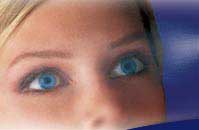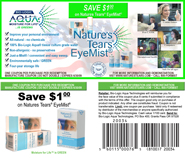
Dr. Marguerite McDonald on Dry Eye Causes and Treatment
Dry Eye, Dry Air and Dehydration Disease
Guest: Marguerite McDonald, MD, (Long Island, NY), Lasik pioneer, Ophthalmologist and dry eye consultant.

(Reference: McDonald, M, MD, "The Forgotten Symptom: Dry Eye in Cataract Patients," Ophthalmology Times, October 1, 2008)
Dry eye and tear film moisture loss are early symptoms of dry air, global drying and dehydration disease. Untreated dry eye can cause corneal ulceration and scarring, eye allergies, eye inflammation, numerous eye diseases and blindness. Because The Sharon Kleyne Hour Power of Water, on World Talk Radio, is devoted to the study of dry air, dehydration diseases and health as part of the power of water; dry eye is a frequent topic. Dry eye guest experts have included Dr. Marguerite McDonald, Dr. Philip Paden, Dr. Robert Latkany, Dr. Ilene Gipson and others.
Dr. Marguerite McDonald
My good friend Dr. Marguerite McDonald, who performed the world's first laser eye surgery in 1988, is an outspoken advocate of eye care education, especially dry eye as caused by the dry eye/dry air crisis and eye dehydration.
The dry eye crisis.
Dry eye (defined as deficiency in the quality and/or volume of water or both in the eye's tear film), according to Marguerite McDonald, is a growing global health problem but is not well understood by most people. Some 9,000,000 people in the U.S. show the advanced effects of dry eye and 50% of the population experiences occasional dry eye symptoms. Dry eye symptoms include fluctuating vision, burning and stinging eyes, eye redness and mild itching, frequent headaches, morning drowsiness, heavy tearing in the late afternoon, frequent need to go to bed early, etc.
The urge to rub the eyes may result from either dry eye or allergies, says Dr. Marguerite McDonald. Rubbing can cause a release of inflammatory chemicals that can make dry eye symptoms even worse. A cold compress with no rubbing is preferred. Dr. Marguerite McDonald also recommends Nature's Tears EyeMist for eye discomfort.
Causes of dry eye.
I asked Dr. Marguerite McDonald about some of the causes of dry eye. Severe dry eye, loss of tear film moisture and other dehydration disease symptoms, she informed me, can accompany arthritis, diabetes, Parkinson's disease, scleroderma, Sjogren's syndrome and other dehydration diseases. Many medications, including blood pressure and cholesterol medications, and many common anti-depressants, can also cause dry eye and eye dehydration. Contact lenses, cataracts, osteoporosis, gout, blink rate disorders, thyroid problems and the first few days after LASIK surgery can also lead to severe dry eye.
Dry eye demographics.
Dry eye is appearing at an increasingly young age in the US, partly because of increasing dry air and dry indoor environments (insulated walls and windows, forced-air heating and cooling), and partly because children are being medicated more. The incidence of dry eye increases with age.
Prevention and treatment of dry eye.
Dr. Marguerite McDonald and I discussed many proactive prevention measures to enhance tear film moisture and alleviate dry eye symptoms. Our best advice - since dry eye is a dehydration disease, just remember the "power of water." Be aware of the air humidity in your home and office and put out bowls of water if the air gets too dry. Get plenty of sleep and drink lots of water. Dr. Marguerite McDonald is a strong advocate of the product "Nature's Tears EyeMist" to naturally supplement the moisture in the eyes' tear film to soothe dry eye.
Click here for the full audio of my interview with John Salinas on Crater Lake National Park, and with Dr. Marguerite McDonald
Click here to view the John Salinas interview
Click here for my Evaluation of the John Salinas interview about Crater Lake National Park
Related Websites:
www.geteyesmart.org,
Related past shows:
October 19, 2009 - Dr. Marguerite McDonald talks about Eyelid Inflammation and Dry Eye
Guest - Dr. Marguerite McDonald
April 7, 2008 - The Nature's Tears EyeMist Breakthrough for Dry Eye and Tear Film Moisture
Guest - Dr. Philip Paden
October 18, 2007 - The Dry Eye Remedy and the Dry Eye Crisis
Guest - Dr. Robert Latkany
October 15, 2007 - Dr. Marguerite McDonald - Vision care tips you might not know about.
Guest - Dr. Marguerite McDonald
July 17, 2008 - LASIK pioneer Dr. Marguerite McDonald talks about the miracle of laser and LASIK surgery
Guest - Dr. Marguerite McDonald









